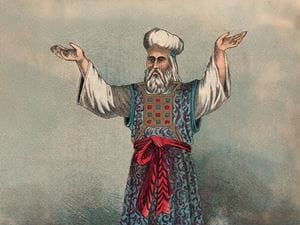
In the Old Testament, God commanded that both the high priest and other priests wear specific garments when ministering in the Tabernacle. These garments were not just for appearance but served deeper, symbolic purposes.
The purpose of the priestly garments in the Old Testament was multifaceted. They symbolized the holiness, purity, and dedication required of priests serving in God's presence.
So, what were these garments, and how did they serve in the worship of God and the spiritual life of Israel?
The Command to Wear Holy Garments
"Then bring forward to yourself your brother Aaron, and his sons with him, from among the sons of Israel, to serve as priests to Me—Aaron, Nadab and Abihu, Eleazar, and Ithamar, Aaron's sons. And you shall make holy garments for Aaron, your brother, for glory and beauty. You shall speak to all the skillful people whom I have endowed with the spirit of wisdom, that they may make Aaron's garments to consecrate him, that he may serve as priest to me. And these are the garments which they shall make: a Breastplate, an ephod, a robe, a tunic of checkered work, a turban, and a sash. They shall make holy garments for your brother Aaron and his sons so that he may serve as priest to Me." (Exodus 28:1-4, NASB)
The garments served both practical and spiritual purposes, symbolizing the priests' consecration and holiness before God.
The High Priest's Garments
Aaronserved as the first high priest of Israel, with his sons designated as priests to serve alongside him. God commanded that all priests wear special garments when ministering before Him. The high priest's attire included:Tunic (with linen undergarments)
- Sash
- Robe
- Breastplate
- Ephod
- Turban
Exodus 28 outlines details about these garments, including the other priests' wearing of undergarments, tunics with sashes, and headbands.
The Function of the Garments
Linen Tunic and Undergarments
The linen tunic and undergarments were designed to keep the priests from sweating while ministering before God. In Ezekiel 44:18, God says, "Linen turbans shall be on their heads and linen undergarments shall be around their waists; they shall not put on anything that makes them sweat." These garments set the priests apart, as they were instructed to change before entering public areas, preventing the transfer of holiness to the people (Ezekiel 44:19).
Robe
"[The robe] shall be on Aaron when he ministers; and its sound shall be heard when he enters and leaves the Holy Place before the Lord so that he will not die" (Exodus 28:25). This robe, adorned with golden bells, provided an audible sign of the high priest's presence in the Holy Place, underscoring the sacredness of his role.
Ephod and Breastplate
The ephod, a type of vest, was secured with a cord around the high priest's waist and featured two onyx stones engraved with the names of Israel's tribes. The Breastplate, mounted with twelve precious stones representing the twelve tribes, also contained the Urim and Thummim for discerning God's will and was referred to as "the Breastplate of judgment" (Exodus 28:15-30).
Turban
The high priest's turban, made of linen, featured a golden plate inscribed with "Holy to the Lord," attached by a violet cord (Exodus 28:36-37). This symbol of holiness marked the high priest as consecrated to God's service.
The Purpose of the Garments
Twice in Exodus 28—in verses 2 and 40—God tells Moses that the garments for Aaron and his sons are "for glory and for beauty." This suggests that the garments were not only practical but symbolized the holiness and set-apart nature of the priests. The priests needed to be "consecrated" to serve before God—both set apart and made holy.
Consecration and Purification
In Exodus 29:44, God says, "I will consecrate the tent of meeting and the altar; I will also consecrate Aaron and his sons to serve as priests to me." This consecration involved sacrifices and the sprinkling of blood on the priests, their garments, and tabernacle furnishings, symbolizing purification. Anointing oil was also used for consecration (Exodus 30:22-30).
Why Were Priestly Garments Important?
The garments visually demonstrated that the priests were set apart for service to God, representing purity, holiness, and dedication. They reminded the priests and the people of God's holiness and the need for sanctification.
Relevance to Christians Today
While most Christians today do not wear special garments, they are still called to be holy.
Peter reminds believers, "But you are a chosen people, a royal priesthood, a holy nation, a people for God's own possession, so that you may proclaim the excellencies of Him who has called you out of darkness into His marvelous light" (1 Peter 2:9).
Just as the priestly garments symbolized holiness and devotion, believers today are called to live with similar attention to spiritual purity and dedication.

